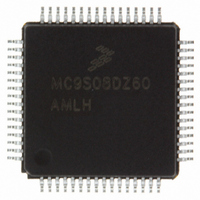MC9S08DZ60MLC Freescale Semiconductor, MC9S08DZ60MLC Datasheet - Page 302

MC9S08DZ60MLC
Manufacturer Part Number
MC9S08DZ60MLC
Description
IC MCU 60K FLASH 4K RAM 32-LQFP
Manufacturer
Freescale Semiconductor
Series
HCS08r
Specifications of MC9S08DZ60MLC
Core Processor
HCS08
Core Size
8-Bit
Speed
40MHz
Connectivity
CAN, I²C, LIN, SCI, SPI
Peripherals
LVD, POR, PWM, WDT
Number Of I /o
25
Program Memory Size
60KB (60K x 8)
Program Memory Type
FLASH
Eeprom Size
2K x 8
Ram Size
4K x 8
Voltage - Supply (vcc/vdd)
2.7 V ~ 5.5 V
Data Converters
A/D 10x12b
Oscillator Type
External
Operating Temperature
-40°C ~ 125°C
Package / Case
32-LQFP
For Use With
DEMO9S08DZ60 - BOARD DEMOEVB9S08DZ60 - BOARD EVAL FOR 9S08DZ60
Lead Free Status / RoHS Status
Lead free / RoHS Compliant
Available stocks
Company
Part Number
Manufacturer
Quantity
Price
Company:
Part Number:
MC9S08DZ60MLC
Manufacturer:
Freescale Semiconductor
Quantity:
10 000
- Current page: 302 of 416
- Download datasheet (5Mb)
Chapter 14 Serial Communications Interface (S08SCIV4)
SCI communications require the transmitter and receiver (which typically derive baud rates from
independent clock sources) to use the same baud rate. Allowed tolerance on this baud frequency depends
on the details of how the receiver synchronizes to the leading edge of the start bit and how bit sampling is
performed.
The MCU resynchronizes to bit boundaries on every high-to-low transition, but in the worst case, there are
no such transitions in the full 10- or 11-bit time character frame so any mismatch in baud rate is
accumulated for the whole character time. For a Freescale Semiconductor SCI system whose bus
frequency is driven by a crystal, the allowed baud rate mismatch is about 4.5percent for 8-bit data format
and about 4 percent for 9-bit data format. Although baud rate modulo di v ider settings do not always
produce baud rates that exactly match standard rates, it is normally possible to get within a few percent,
which is acceptable for reliable communications.
14.3.2
This section describes the overall block diagram for the SCI transmitter, as well as specialized functions
for sending break and idle characters. The transmitter block diagram is shown in
The transmitter output (TxD) idle state defaults to logic high (TXINV = 0 following reset). The transmitter
output is inverted by setting TXINV = 1. The transmitter is enabled by setting the TE bit in SCIxC2. This
queues a preamble character that is one full character frame of the idle state. The transmitter then remains
idle until data is available in the transmit data buffer. Programs store data into the transmit data buffer by
writing to the SCI data register (SCIxD).
The central element of the SCI transmitter is the transmit shift register that is either 10 or 11 bits long
depending on the setting in the M control bit. For the remainder of this section, we will assume M = 0,
selecting the normal 8-bit data mode. In 8-bit data mode, the shift register holds a start bit, eight data bits,
and a stop bit. When the transmit shift register is available for a new SCI character, the value waiting in
the transmit data register is transferred to the shift register (synchronized with the baud rate clock) and the
transmit data register empty (TDRE) status flag is set to indicate another character may be written to the
transmit data buffer at SCIxD.
If no new character is waiting in the transmit data buffer after a stop bit is shifted out the TxD pin, the
transmitter sets the transmit complete flag and enters an idle mode, with TxD high, waiting for more
characters to transmit.
302
Transmitter Functional Description
BUSCLK
BAUD RATE GENERATOR
OFF IF [SBR12:SBR0] = 0
MODULO DIVIDE BY
(1 THROUGH 8191)
Figure 14-12. SCI Baud Rate Generation
SBR12:SBR0
MC9S08DZ60 Series Data Sheet, Rev. 4
BAUD RATE =
DIVIDE BY
16
Rx SAMPLING CLOCK
(16 × BAUD RATE)
[SBR12:SBR0] × 16
BUSCLK
Tx BAUD RATE
Figure
Freescale Semiconductor
14-2.
Related parts for MC9S08DZ60MLC
Image
Part Number
Description
Manufacturer
Datasheet
Request
R
Part Number:
Description:
Manufacturer:
Freescale Semiconductor, Inc
Datasheet:
Part Number:
Description:
Manufacturer:
Freescale Semiconductor, Inc
Datasheet:
Part Number:
Description:
Manufacturer:
Freescale Semiconductor, Inc
Datasheet:
Part Number:
Description:
Manufacturer:
Freescale Semiconductor, Inc
Datasheet:
Part Number:
Description:
Manufacturer:
Freescale Semiconductor, Inc
Datasheet:
Part Number:
Description:
Manufacturer:
Freescale Semiconductor, Inc
Datasheet:
Part Number:
Description:
Manufacturer:
Freescale Semiconductor, Inc
Datasheet:
Part Number:
Description:
Manufacturer:
Freescale Semiconductor, Inc
Datasheet:
Part Number:
Description:
Manufacturer:
Freescale Semiconductor, Inc
Datasheet:
Part Number:
Description:
Manufacturer:
Freescale Semiconductor, Inc
Datasheet:
Part Number:
Description:
Manufacturer:
Freescale Semiconductor, Inc
Datasheet:
Part Number:
Description:
Manufacturer:
Freescale Semiconductor, Inc
Datasheet:
Part Number:
Description:
Manufacturer:
Freescale Semiconductor, Inc
Datasheet:
Part Number:
Description:
Manufacturer:
Freescale Semiconductor, Inc
Datasheet:
Part Number:
Description:
Manufacturer:
Freescale Semiconductor, Inc
Datasheet:











